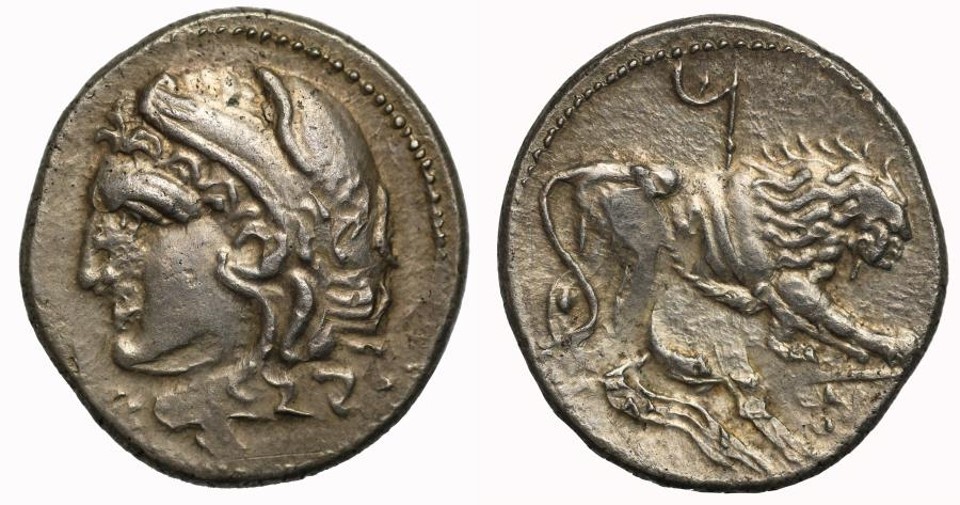241 BCE - 237 BCE | ΛΙΒΥΩΝ
Overstriking coin
Sovereign_Rarities.jpg
|
|
Sale(s)Sale(s) ᵖ:
|
Sovereign Rarities
|
|
|
|
Description
| ObverseInscription or printing placed on the obverse.:
|
Head of Herakles left, wearing lion skin headdress. Border of dots.
|
ReverseInscription or printing placed on the reverse.:
|
ΛΙΒΥΩΝ Lion prowling right. Above, 'M' (Punic letter). Border of dots.
|
Mint and issuing power
| MintIdentifies the place of manufacture or issue of a numismatic object.:
|
Carthage
|
Ancient regionAncient region.
|
Zeugitana
|
Modern countryModern country: Tunisia
|
AuthorityIdentifies the issuing power. The authority can be "pretended" when the name or the portrait of X is on the coin but he/she was not the issuing power. It can also be "uncertain" when there is no mention of X on the coin but he/she was the issuing power according to the historical sources:
|
Carthaginian Empire, Lybian mercenaries (241-237 BCE)
|
Chronology
| FromIdentifies the initial date in a range assigned in a numismatic context. 241 BCE toIdentifies the final date in a range assigned in a numismatic context.. 237 BCE
|
Hellenistic 323-30 BC  periodTime period of the numismatic object. periodTime period of the numismatic object.
|
Physical description
MetalThe physical material (usually metal) from which an object is made.: Silver 
|
WeightWeight of the numismatic object (in grams). in grams: 7.177.17 g <br />7,170 mg <br />
|
DenominationTerm indicating the value of a numismatic object. Examples: tetradrachm, chalkous, denarius.: shekel 
|
AxisDescribes the directional relationship between the obverse and reverse of a numismatic object.: 1212 mm <br />1.2 cm <br />
|
|
|
|
References
Description
| ObverseInscription or printing placed on the obverse.:
|
|
ReverseInscription or printing placed on the reverse.:
|
Horse r.
|
Mint and issuing power
| MintIdentifies the place of manufacture or issue of a numismatic object. ᵖ:
|
|
Ancient regionAncient region. ᵖ
|
|
Modern countryModern country:
|
AuthorityIdentifies the authority in whose name (explicitly or implicitly) a numismatic object was issued. ᵖ:
|
|
Chronology
| FromIdentifies the initial date in a range assigned in a numismatic context. toIdentifies the final date in a range assigned in a numismatic context..
|
periodTime period of the numismatic object.
|
Physical description
| DenominationTerm indicating the value of a numismatic object. Examples: tetradrachm, chalkous, denarius. ᵖ:
|
shekel 
|
|
|
References
References
- ^ Carradice, Ian A. - La Niece, Susan (1988), "The Libyan War and Coinage: a New Hoard and the Evidence of Metal Analysis," Numismatic Chronicle, 148, p. 33-52, 6 pl.
- ^ Jenkins, Gilbert Kenneth (1992), Sylloge Nummorum Graecorum: Royal Collection of Coins and Medals. Danish National Museum, volume 8. Egypt, North Africa, Spain, Gaul. Sunrise Publ., Inc.
- ^ Alexandropoulos, Jacques (2007), Les monnaies de l'Afrique antique (400 av. J.-C.-40 ap. J.-C.), Presses universitaires du Mirail, Toulouse, 507 p., 17 pl.
